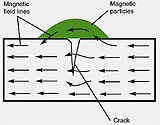Magnetic Particle Testing
 Scientific Principles
Scientific Principles
A magnetic field is established in a component made from ferromagnetic material. The magnetic lines of force travel through the material, and exit and reenter the material at the poles. Defects such as crack or voids cannot support as much flux, and force some of the flux outside of the part. Magnetic particles distributed over the component will be attracted to areas of flux leakage and produce a visible indication.
Main Uses
- Used to inspect ferromagnetic materials (those that can be magnetized) for defects that result in a transition in the magnetic permeability of a material.
- Magnetic particle inspection can detect surface and near surface defects.
Main Advantages
- Large surface areas of complex parts can be inspected rapidly.
- Can detect surface and subsurface flaws.
- Surface preparation is less critical than it is in penetrant inspection.
- Magnetic particle indications are produced directly on the surface of the part and form an image of the discontinuity.
- Equipment costs are relatively low.
Disadvantages
- Only ferromagnetic materials can be inspected.
- Proper alignment of magnetic field and defect is critical.
- Large currents are needed for very large parts.
- Requires relatively smooth surface.
- Paint or other nonmagnetic coverings adversely affect sensitivity.
- Demagnetization and post cleaning is usually necessary.



